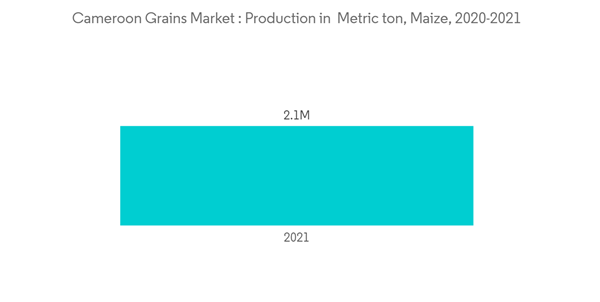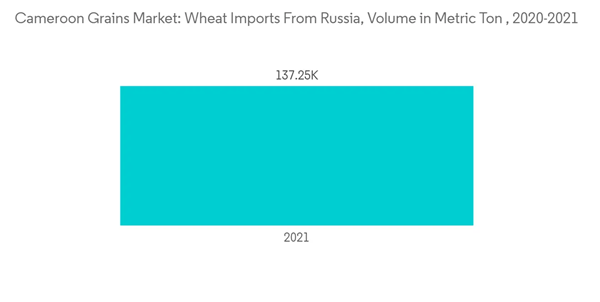Key Highlights
- The market focuses on catering to domestic demands. The grains market includes cereal crops, pulses, and oilseeds. Cameroon is not a self-sufficient country when it comes to the cereal market. As a result, various cereal crops are imported from other countries.
- Maize is the most widely cultivated cereal crop, with a harvest area of about 11,86,193 hectares. According to Food and Agriculture Organization Corporate Statistical (FAOSTAT) database, maize production was around 2.3 million metric tons in 2021. The most widely cultivated crops in the country among pulses are beans, followed by cowpea, and, among oilseeds, groundnut, followed by sesame. Groundnut production, one of the country's major oil crops, was 500,000 metric tons in 2021.
- Wheat consumption is high in the country. However, domestic wheat production is not sufficient enought to fulfill the consumption rate; hence, Cameroon exports a large quantity of wheat and is one of the biggest wheat importers. However, to increase self-sufficiency, the country's President increased funding to increase wheat production within the country, especially after a protest sparked due to the shortage of wheat in the country.
Cameroon Grains Market Trends
Increasing Demand for Animal Feed
- The constant increase in the demand for animal feed is due to the increased animal population across the country. Private companies, as well as the government of Cameroon, are focusing on the development of feed production in the region, which will ultimately boost their economic structure. For instance, the government started the livestock project in 2020, which will end in 2024, to develop more infrastructure for livestock and increase the production of feed for the animals.
- Furthermore, In 2021, Cameroonian animal feed producer SPC expanded its company in the region. The company invested in its new plant to start its activities of animal feed production. The feed formula includes locally-grown raw materials that provide the energy and protein required to ensure the nutritional optimization of the product range: maize and derivatives, soya, groundnut, cotton, and palm kernel meal.
- Maize is the primary source of animal feed in Cameroon. The Food and Agriculture Organization (FAO) describes it as the king of feed ingredients because of its high energy content and digestibility. Maize and protein concentrate traditionally comprise over 70% of farm-made diets. Increasing demand from the animal feed industry is stressing the production of maize. Hence, farmers are responding with improved yields by adopting high-yielding varieties and hybrid seeds, and production has been increasing.
- According to Food and Agriculture Organization (FAO), the production of maize in the country was reported at 2,100,146.82 metric tons in the year 2021, which was 2,091,263.2 metric tons in 2020.
Wheat Consumption High among Cereals
- The grains market can be broadly segmented into three categories: cereal crops, pulses, and oilseeds. Maize, rice, sorghum, and millet are the major cereal crops cultivated across various parts of Cameroon. Although the production of wheat in the country is increasing, consumption is gradually increasing, leading to increased imports. The country imports 60% of its wheat from Ukraine. Russia and Ukraine are the largest exporters of wheat to the country. However, the Russia-Ukraine war impacted the import of wheat.
- The war between Russia and Ukraine disrupted the country's situation. In 2022, protests sparked in the country because of a shortage of wheat and a price hike. Hence, to reduce the import dependency, the Cameroonian government invested USD 15 million in wheat production in the country.
Cameroon Grains Industry Overview
Additional Benefits:
- The market estimate (ME) sheet in Excel format
- 3 months of analyst support
This product will be delivered within 2 business days.










